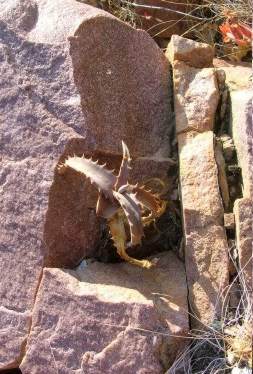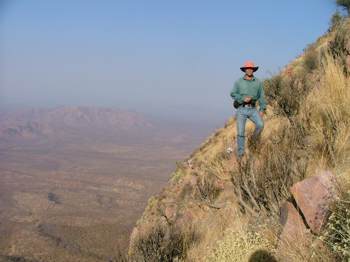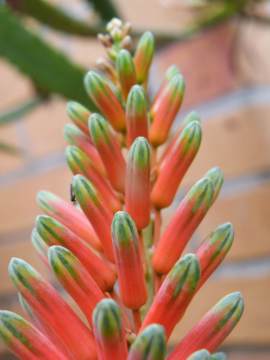Aloe huntleyana
Aloe huntleyana Van Jaarsv. & Swanepoel
Family: Asphodelaceae
Common names: Huntley aloe (Eng.); Huntley-aalwyn (Afr.)
Introduction
Aloe huntleyana is a small creeping aloe species with greyish green leaves ornamented at the base with white spots. It branches to form clusters of up to a metre in diameter. It is only known from Omavanda, a small region near the highest plateau of the Otjihipa Mountains in Namibia, where the plants grow on broken cliffs. It is easily propagated and can be grown in gardens or containers. Aloe huntleyana is one of 29 species of Aloe indigenous to Namibia.

Description
Description
Plants arborescent, sprouting from the base and with leaning branches forming loose spreading to pendent clusters of up to 2m wide. The roots are fleshy. The leafy branches are not straight (12-14mm in diameter), often with a slight zig-zag appearance, and the leaves tending to be crowded in apical rosettes of about 300-400mm in diameter. The internodes are 15-20mm long.

Leaves are linear-lanceolate up to 180×20-30mm in diameter, spreading, recurved in upper half, slightly sickle-shaped, greyish green but turning reddish in the dry season. The upper surfaces are flat to convex, becoming slightly channelled during the dry season. The lower surfaces are convex, sparingly spotted in the lower halves, and distinctly striate along the leaf base surrounding the internodes (amplexicaul). The leaf margins are armed with yellowish green, pungent teeth, 3-5mm long and 8-12mm apart. The leaves narrow towards the tips (acuminate).

The inflorescence are up to 300-400mm long, simple, or divaricate with up to 3 branches in the lower half. The racemes (130-150mm long and 40-50mm in diameter) are rounded-triangular with the flowers arranged fairly densely. The flowers are cylindrical and slightly decurved, 28-29mm long, reddish, becoming whitish and yellowish at the apex in open flowers. Capsules are rounded elongate.
Conservation Status
Status
Aloe huntleyana is only known from one location near the highest plateau in Namibia and can only be reached by foot on a long journey. With its limited distribution, and inaccessible cliff face habit, it is well protected. Due to its ease of growth and propagation by cuttings, the plant is now also established in cultivation (ex situ conservation) and grown by numerous succulent plant growers.

Distribution and habitat
Distribution description
Aloe huntleyana is confined to the quartzitic sandstone escarpment margin (eastern aspects) overlooking the Kunene Valley in Kaokoveld, northern Namibia, at an altitude of 1800-2000m, not far from the well-known Epupa Falls in the Kunene River. The vegetation is essentialy savanna with plants such as Combretum apiculatum, C. zeyheri, Cyphostemma currorii, Entandrophragma spicatum, Kirkia acuminata and Mundulea sericea being prominent. Associated cliff-dwelling species include Cotyledon orbiculata, Cyphostemma currorii, Euphorbia subsalsa, E. monteiroi, Kalanchoe lanceolata and Sarcostemma viminale.

Omavanda is situated within the tropics, with hot summers and dry, warm winters without frost. Rainfall occurs mainly in summer; about 300-500mm per annum. Fires are a regular phenomenon in savanna and the habitat where A. huntleyana grows is no exception. However, although A. huntleyana would re-sprout from its base after a fire, plants often grow in rock crevices or screes where fire cannot reach them.
Derivation of name and historical aspects
History
This species was named in 2012 from plants collected by Steven Carr, Wessel Swanepoel and the author on an expedition to Kaokoveld in 2004. The specific name, huntleyana, honours Professor Brian Huntley, former director of the National Botanical Institute, who sponsored the author on a expedition to Angola whereby the relationship of A. huntleyana to its close relatives (A. vallaris, A. scorpioides and A. catengiana) could be studied in detail, establishing its status as a new species. Professor Huntley was director for a period of 20 years, during which the Institute went from strength to strength under his leadership. Aloe huntleyana was first thought to be a southern extension of A. catengiana (from Catengua in Angola). It was only after Mr Duke Benadon from the USA provided illustrations of that species that its true identity could be established.
Ecology
Ecology
Aloe huntleyana flowers during autumn (April to June). Plants are pollinated by sunbirds and seeds are dispersed by wind in winter, just before the spring and summer rains. The plants grow on quartztic sandstone ledges in full sun or partial shade. In vegetative features, A. huntleyana resembles A. vallaris, a species from the western Angolan escarpment near Humpata (Leba Pass and Tjivingueru). Branches becoming detached from the mother plant will also root, thus, the plant has a vegetative means of dispersal as well.
Uses
Use
Apart from its popularity in cultivation, no medicinal uses have been recorded for this species.
Growing Aloe huntleyana
Grow

Aloe huntleyana is an attractive small plant, best grown in dry savanna gardens on rockeries. In regions where frost is a problem it can be grown indoors with ease, as long as sufficient light is available. It is an easy-grower, and can be grown in full sun or partial shade. Propagation from branches is easy with plants thriving in containers.
Root branches in sand. Cuttings can also be planted directly in a container with well-drained soil. The cuttings root rapidly and can be transferred to a chosen site as soon as they are established .
References
- Van Jaarsveld, E.J. & Swanepoel, W. 2012. Aloe huntleyana , a new species from the Baynes Mountains, Namibia . Bradleya 30: 3-8.
- Van Jaarsveld, E.J. 2013. Aloes of Angola and Namibia. Aloe 50: 1 & 2, 24-29.
Credits
Ernst van Jaarsveld
Kirstenbosch National Botanical Garden
May 2014
Plant Attributes:
Plant Type: Succulent
SA Distribution:
Soil type: Sandy, Loam
Flowering season: Autumn, Winter
PH: Acid
Flower colour: Red
Aspect: Full Sun, Morning Sun (Semi Shade), Afternoon Sun (Semi Shade)
Gardening skill: Easy
Special Features:
Horticultural zones









Rate this article
Article well written and informative
Rate this plant
Is this an interesting plant?
Login to add your Comment
Back to topNot registered yet? Click here to register.